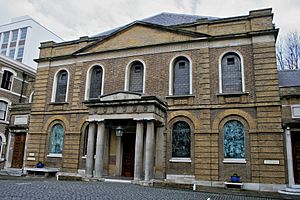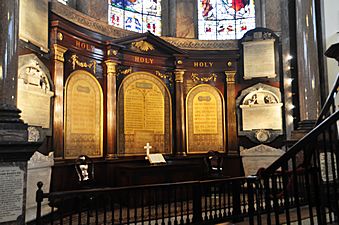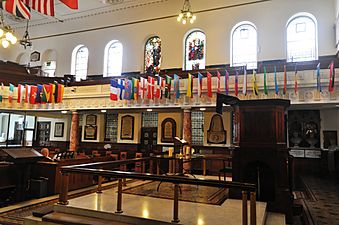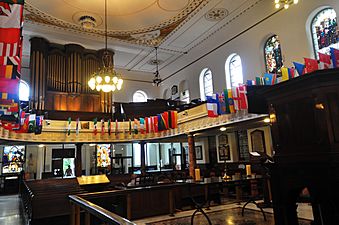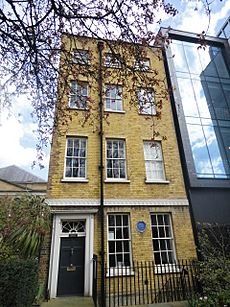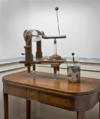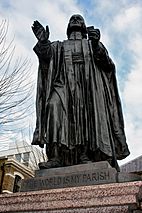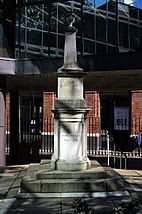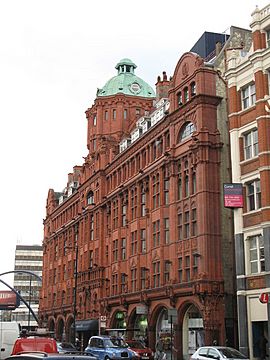Wesley's Chapel facts for kids
Quick facts for kids Wesley's Chapel |
|
|---|---|
| Wesley's Chapel and Leysian Mission | |

Chapel and courtyard
|
|
| Location | 49 City Road, St Luke's, London |
| Country | United Kingdom |
| Denomination | Methodist Church of Great Britain |
| History | |
| Founded | 1778 |
| Founder(s) | John Wesley |
| Dedicated | 1778 |
| Architecture | |
| Architect(s) | George Dance the Younger |
| Style | Georgian architecture |
| Administration | |
| Circuit | City Road |
Wesley's Chapel, also known as the City Road Chapel, is a famous Methodist church in London. It opened in 1778. John Wesley, who started the Methodist movement, helped build it.
This special place is a church and a popular spot for visitors. It includes the Museum of Methodism in its basement and John Wesley's House right next to the chapel. Many people call it "The Mother Church of World Methodism" because it's so important to Methodism.
Wesley's Chapel is part of the London District of the Methodist Church. It works with the Leysian Mission. In 2018, about 320 people attended services there each week. As of 2023, the church had 447 members.
Contents
History and Design of the Chapel
In 1776, John Wesley, the leader of the Methodists, asked the City of London for land. He wanted to build a new chapel. He was given a piece of land on City Road. People from all over the Methodist movement helped raise money.
The first stone for the chapel was laid on April 21, 1777. The architect was George Dance the Younger, who worked for the City of London. Samuel Tooth, a member of Wesley's group, was the builder. The chapel officially opened with a service on November 1, 1778. This new chapel replaced Wesley's older London church, called the Foundery. Wesley first preached there on November 11, 1739.
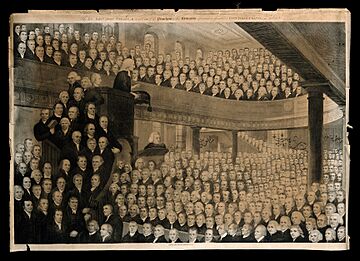
Wesley's Chapel is made of brown bricks with yellow brick and stone details. It is a Grade I listed building, which means it's very important historically. It's a great example of Georgian architecture, even though it has been changed over time. For example, the plain windows were replaced with stained glass in the 1800s.
In 1864, the gallery inside was updated. Its front was made lower, and the seats were angled for better viewing. Around the gallery, there's a special design. It shows a dove with an olive branch inside a snake biting its own tail. This design was supposedly created by Wesley himself. The ceiling was replaced with a copy after a fire in 1879.
Another big update happened in 1891. Holloway Brothers worked with Methodist architects Elijah Hoole and William Willmer Pocock. The building's foundations were made stronger. The windows in the apse (a rounded part of the church) were made bigger for stained glass. New pews, which are church benches, were also added.
The pillars supporting the gallery were originally ships' masts. These were given by King George III. But they were replaced with French jasper pillars donated by Methodist churches from other countries. Only the top part of the original three-level pulpit (where the preacher stands) is still there. An organ was put in in 1882, and the current one in 1891. It was made electric in 1905. In 1938, its pipes were moved to the back of the gallery.
The original sanctuary (the area around the altar) was behind the pulpit. This was common in 18th-century churches designed for listening. Not many examples like this still exist today. The current sanctuary in front of the pulpit was added during repairs in the 1970s. During these repairs, the foundations were strengthened again, and the roof was replaced.
The chapel was officially reopened on November 1, 1978. Queen Elizabeth II and Prince Philip, Duke of Edinburgh attended the ceremony. The current communion rail was given in 1993. It was a gift from former Prime Minister Margaret Thatcher, who got married in the chapel in 1951.
Wesley's Chapel has always had two or more ministers. Sometimes, local preachers lead services. The first woman to preach in Wesley's Chapel was Agnes Elizabeth Slack, in 1926.
Inside Wesley's Chapel
- Interior of Wesley's Chapel
The Chapel Site
The chapel is located in a cobbled courtyard off City Road. The chapel is at the far end, and Wesley's house is on the right.
John Wesley's House
John Wesley's House is a mid-Georgian townhouse. It was built in 1779, at the same time as the chapel. Wesley lived here for the last eleven years of his life. A blue plaque on the front of the house remembers him. This Grade I listed building is open to visitors as a historic house museum. Wesley built it, and George Dance the younger designed it.
Wesley lived in the house for his last twelve years and died in his bedroom. The house also provided a place for traveling preachers and their families to stay. The household servants lived there too. After Wesley's death, the house continued to be used by traveling preachers. It became a museum in the 1900s.
In the dining room, you can see his Chamber Horse. He used this for exercise. In his study, there's an electric machine. This machine was used to treat illnesses.
-
John Wesley blue plaque
Courtyard, Gardens, and Cemetery
In front of Wesley's House is a small physic garden. This garden has herbs mentioned in Wesley's book, The Primitive Physic. This book explained how ordinary people could use natural medicines to cure themselves. This was important because they often couldn't afford a doctor.
Wesley passed away on March 2, 1791. His tomb is in the garden behind the chapel. Next to him are the graves of six of his preachers. His sister Martha Hall and his doctor, Dr John Whitehead, are also buried there.
A memorial to Susanna Wesley, John Wesley's mother, stands just inside the front courtyard gate.
A bronze statue of Wesley stands at the entrance to the courtyard. It has the words "the world is my parish" on it. John Adams-Acton created this statue in 1891. It is a Grade II listed sculpture. Elijah Hoole designed the 10-foot tall granite base for the statue.
Victorian Toilets
The site also has one of the few remaining examples of men's toilets built by the engineer Thomas Crapper in 1891.
The Leysian Mission
In 1886, former students of The Leys School in Cambridge started a Christian mission nearby. Their goal was to help the poor people living in the East End of London. In 1904, the mission moved to a new location very close to Wesley's Chapel. It offered medical help, legal advice, and support with money and food. It also held religious services and music events. After World War II, the mission sold its buildings. In 1989, it joined with Wesley's Chapel.
Wesley's Chapel Today
The chapel is home to a diverse group of people. It has 447 members. It is an active church with daily prayers and Sunday services. It is known for its traditional worship style. The main minister is Canon Jennifer Smith.
Wesley's Chapel works closely with other churches. These include the Anglican St Giles' Cripplegate parish church, Jewin Welsh Presbyterian Chapel, and St Joseph's Roman Catholic Church. It also has a good relationship with the Friends meeting house at Bunhill Fields.
Museum of Methodism
The Museum of Methodism is located in the chapel's crypt (basement). It holds many items related to Methodism. These include some of Wesley's speeches and writings about faith. You can also see a "warmed heart" "contemplative space." Other items include Thomas Coke's writing desk and Donald Soper's portable preaching stand. The museum was created in 1978. It was updated in 2014, and the last display was added in early 2016.
See also
- List of Methodist churches
- New Room, Bristol
- Charles Wesley's House
External links
- Wesley's Chapel, London – official website
- The Museum of Methodism & John Wesley's House – official website
- Wesley's Chapel and Museum of Methodism – Sacred Destinations
- Virtual Tour of Wesley's Chapel – RE:Quest
- Wesley's Chapel The Museum of Methodism & The John Wesley House – AboutBritain
- Profile at Visit London – London's official website


